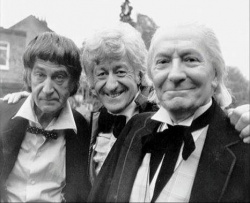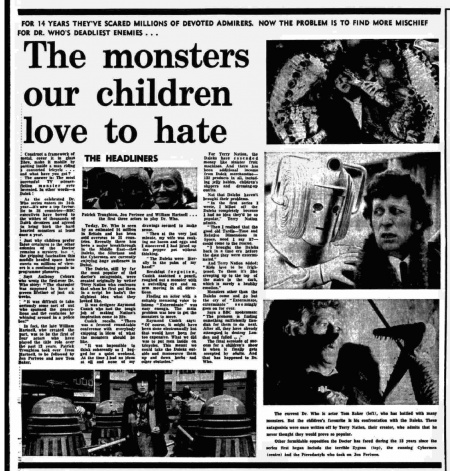The monsters our children love to hate
- Publication: Liverpool Echo
- Date: 1977-01-29
- Author:
- Page: 7
- Language: English
For 14 years they've scared millions of devoted admirers. Now the problem is to find more mischief for Dr. Who's deadliest enemies
But construct a framework of metal, cover it in glass fibre, make it mobile by putting the inside a man riding a converted tricycle and what have you got?
The answer is: the most successful TV science fiction monster ever invented. In other words - a Dalek!
As the celebrated Dr. Who series enters its 14th year dash it's now a top favorite in 26 countries - BBC executives have bowed to the wishes of thousands of Dalek devote a ease and agreed to bring back the hard-hearted monsters at least once a year.
Just why children prefer these creatures to the other enemies of the Doctor remains a mystery. Indeed a gripping fascination this model head in space hero exerts on millions of viewers is a continuing puzzle to the programme planners.
Says Anthony Coburn who wrote the first ever Dr. Who story: "The character was supposed to have a screen lifetime of just six weeks.
"It was difficult to take seriously some sort of not who spend the generations and the centuries by whizzing around in a police box!"
In fact, the late William Hartnell, who created the part, was the first of four actors to have played the title role over the past 13 years. Patrick Troughton took over from Hartnell, to be followed by Jon Pertwee and now a Tom Baker.
To-day, Dr. Who is seen by an estimated 14 million in Britain and has been sold overseas to 25 countries. Recently there has been a major breakthrough in the Middle East - the Daleks, the Silurians and the Cybermen are currently enjoying huge audiences in Dubai.
The Daleks, still by far the most popular of the doctor's antagonists, were created originally by writer Terry Nation who confesses that when he first put them in a script he had the slightest idea what they looked like.
It was designer Raymond Cusick who had the tough job of making nations inspiration come to life.
Cusick recalls. "There was a fevered round-table conference with everybody chipping in ideas of what the monster should look like.
"It was impossible to think coherently so I begged for a quiet weekend. All the time I had no ideas at all and none of my drawings seemed to make sense.
"Then at the very last minute my wife was cooking me bacon and eggs and I discovered I had lifted up the pepper pot without thinking.
"The Daleks were literally in the palm of my hand!"
Breakfast forgotten, Cusick snatched a pencil, roughed out a monster with a swivelling eye and an arm moving in all directions.
Finding an actor with a suitably menacing voice to intone "Exterminate" was easy enough. The main problem was how to get the monsters to move.
Raymond Cusick says: "Of course, it might have been done electronically but that would have been far too expensive. What we did was to put men inside on tricycles. This meant we could take the Daleks outside and manoeuver them up and down kerbs and other obstacles.
For Terry Nation, the Daleks have cascaded money like sinister fruit machines. And there has been additional income from Dalek merchandise - 132 products in all, including jelly babies, children's slippers and dressing-up outfits.
Not that the Daleks haven't brought their problems.
"In the first series I wrote, I killed off the docks completely because I had no idea they'd be so popular," Terry Nation admits.
"Then I realized that the good old TARDIS - time and relative dimensions in space, need I say it? - could come to the rescue.
"I brought the Daleks back in a time eraw before the date they were exterminated."
And Terry Nation added: "Kids love to be frightened. To them it's like creeping up to the top of the stairs in the dark, which is surely a healthy emotion."
Monsters other than the Daleks come and go but the cry of "Exterminate, exterminate" seemingly goes on for ever.
Says a BBC spokesman: "The problem is finding something sufficiently fiendish for them to do next. After all, they've already attempted to destroy London and failed.
The final accolade of success for children show is when it finally gets accepted by adults. And that has happened to Dr. Who.
Caption: the current Dr. Who is actor Tom Baker left, who has battled with many monsters. But the children's favorite is his confrontation with the Daleks. These antagonists were once written off by Terry Nation, their creator, would Mets that he never thought they would prove so popular.
Other formidable opposition to the Dr. Has faced during the 13 years since the series for spring can include the terrible Zygons top, The coming Cybermen Center and the pterodactyls who took on Jon Pertwee.
Caption: Patrick Troughton, Jon Pertwee and William Hartnell the first three actors to play Dr. Who.
Disclaimer: These citations are created on-the-fly using primitive parsing techniques. You should double-check all citations. Send feedback to whovian@cuttingsarchive.org
- APA 6th ed.: (1977-01-29). The monsters our children love to hate. Liverpool Echo p. 7.
- MLA 7th ed.: "The monsters our children love to hate." Liverpool Echo [add city] 1977-01-29, 7. Print.
- Chicago 15th ed.: "The monsters our children love to hate." Liverpool Echo, edition, sec., 1977-01-29
- Turabian: "The monsters our children love to hate." Liverpool Echo, 1977-01-29, section, 7 edition.
- Wikipedia (this article): <ref>{{cite news| title=The monsters our children love to hate | url=http://cuttingsarchive.org/index.php/The_monsters_our_children_love_to_hate | work=Liverpool Echo | pages=7 | date=1977-01-29 | via=Doctor Who Cuttings Archive | accessdate=5 December 2025 }}</ref>
- Wikipedia (this page): <ref>{{cite web | title=The monsters our children love to hate | url=http://cuttingsarchive.org/index.php/The_monsters_our_children_love_to_hate | work=Doctor Who Cuttings Archive | accessdate=5 December 2025}}</ref>

